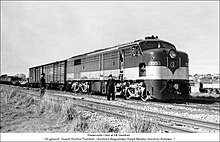| South Australian Railways 930 class | |||||||||||||||||||||||
|---|---|---|---|---|---|---|---|---|---|---|---|---|---|---|---|---|---|---|---|---|---|---|---|
 Preserved SAR class leader number 930 at the
National Railway Museum in 2022 | |||||||||||||||||||||||
| |||||||||||||||||||||||
| |||||||||||||||||||||||
| |||||||||||||||||||||||
| |||||||||||||||||||||||
The South Australian Railways 930 class was a class of diesel-electric locomotives built for the South Australian Railways between 1955 and 1967 by AE Goodwin, Auburn, New South Wales, the Australian licensee of the American Locomotive Company (Alco). Based on the Alco DL500B World series model, they were fitted with Alco 12-251B four-stroke V12 turbocharged diesel engines that developed 1600 horsepower (1190 kilowatts) for traction. The first six of the class had a driving cab at one end only; the remaining 31 locomotives had two. The latter series, up-rated, were the basis of the almost identical New South Wales 44 class, of which 100 were built from 1957. [1]
History

The first six (single-ended) locomotives were delivered in 1955 and 1956 to operate over the steeply graded Adelaide to Tailem Bend line and onwards to Serviceton. A further 31 (double-ended) entered service between July 1957 and June 1967 and operated across the broad-gauge network. The double-ended locomotives had a "bulldog" nose at the "A" end (not as round as the Clyde–GM " Bulldog nose" type) and were flat at the "B" end . All were delivered with broad-gauge bogies and worked across the South Australian Railways network. [2] In hot weather, crews frequently marshalled the locomotives with the "B" end leading so that the front door could be opened to provide more air circulation. [3]
In March 1978, all were included in the transfer of the South Australian Railways to Australian National. From 1982, some were converted to standard gauge using bogies from State Rail Authority 44 class locomotives hauling trains from Adelaide to Whyalla and Broken Hill. [4] On the broad gauge, some began operating through to Melbourne in the mid-1980s. [5]
In 1986, a new computer system required the class leaders of the former South Australian Railways to be renumbered as the last member of the class, with 930 becoming 967. [6]
Withdrawals commenced in 1986; only two remained by January 1994. [5] [7] [8] [9] Only 961 was included in the sale of Australian National's freight operations to Australian Southern Railroad in November 1997. In May 2001 it was sold to Silverton Rail as 44s1. In March 2005 it passed to Chicago Freight Car Leasing Australia.
Disposition
As of 2022 [update], the disposition of the four remaining members of the class was as follows:
| No. | Owner | Location | Notes |
|---|---|---|---|
| 930 | National Railway Museum | Port Adelaide, SA | Static display. SAR maroon and silver livery. [2] |
| 958 | SteamRanger Heritage Railway | Mount Barker, SA | In operational condition. AN green and yellow livery without logos. [10] |
| 961 | Private owner | Goulburn roundhouse, NSW | Under restoration. AN Explorer blue and yellow livery. [ citation needed] |
| 963 | SteamRanger Heritage Railway | Mount Barker | Non-operational. AN green and yellow livery. [11][ citation needed] |
Bibliography
- A guide to Australian Locomotion. Australian Railway Historical Society. 2009. ISBN 978-0-9805106-3-8.
References
- ^ Oberg, Leon (1975). Locomotives of Australia. Terrey Hills, New South Wales: A.H. & A.W. Reed Pty Ltd. p. 219. ISBN 9780589071738.
- ^ a b "Locomotive 930". National Railway Museum, Port Adelaide. Retrieved 6 October 2022.
- ^ Morahan, M. (February 1985). "The 42 class of NSW". Australian Railway Historical Society Bulletin. XXXVI (568). Australian Railway Historical Society, New South Wales Division: 34. ISSN 0005-0105.
- ^ Oberg, Leon (1984). Locomotives of Australia 1850's – 1980's. Frenchs Forest: Reed Books. p. 225. ISBN 0-730100-05-7.
- ^ a b "961 – An Alco Survivor". Railway Digest. June 1999. p. 27.
- ^ "Australian National Broken Hill Line Report". Railway Digest: 314. October 1986.
- ^ "930 Class (SA, Diesel-Electric)". Railpage. Retrieved 2 May 2016.
- ^ "930 Class". VICSIG. Retrieved 2 May 2016.
- ^ "Broad/Standard Gauge 930-class diesel locomotives". Chris's Commonwealth Railways Information. Retrieved 2 May 2016.
- ^ "Diesel Locos and Railcars". Steamranger Enthusiast Pages. Retrieved 6 October 2022.
- ^ "Rolling stock Register". SteamRanger Enthusiast Pages. Retrieved 2 May 2016.